Choosing the Ideal Wetsuit for 30-Degree Water
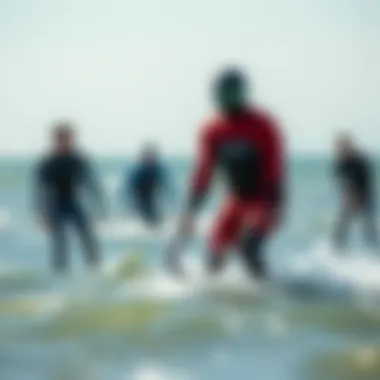
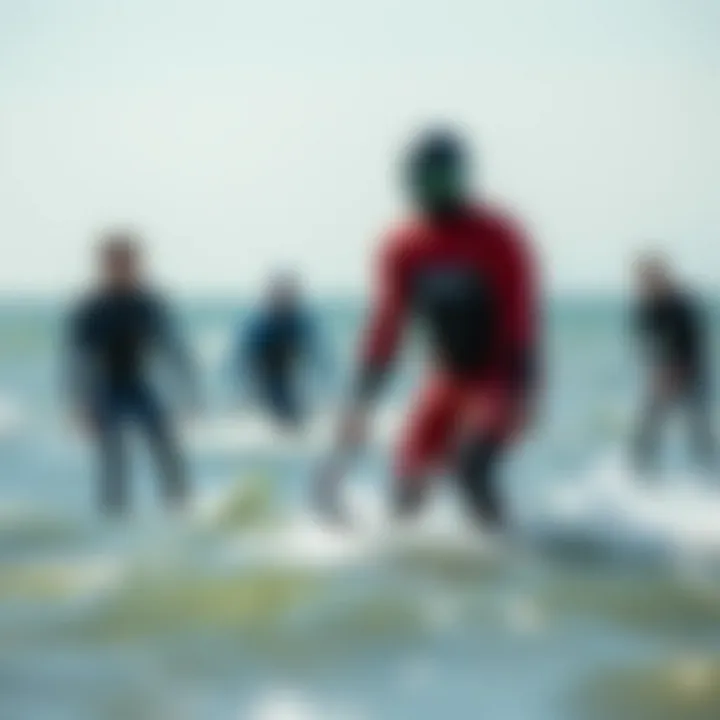
Intro
Selecting the right wetsuit can feel like navigating a complex maze, especially for kiteboarders who want to make the most of their time on the water. With temperatures hovering around 30 degrees Celsius, finding a suit that strikes the right balance between warmth, flexibility, and comfort is essential. This guide not only provides detailed insights into wetsuit materials, thickness, and fit, but also highlights the specific needs of kiteboarding enthusiasts. We’ll break down misconceptions and provide handy maintenance tips to keep your wetsuit in top-notch condition.
Whether you’re a seasoned kiteboarder or just starting out, understanding the nuances of wetsuit selection can greatly influence your performance and comfort. Let’s dive deeper into the world of kiteboarding gear and figure out how to choose the perfect wetsuit to ride the waves.
Understanding Water Temperature and Suit Selection
Water temperature plays a pivotal role in the selection of wetsuits, especially for kiteboarders who are often exposed to the elements. Understanding the specific characteristics of water at 30 degrees Celsius is crucial. This knowledge not only aids in choosing the right wetsuit but also ensures safety and comfort during kiteboarding sessions.
Importance of Water Temperature in Wetsuit Choices
Selecting a wetsuit is not a one-size-fits-all scenario. At 30 degrees, the water is warm enough to allow for some flexibility in suit choices, but various factors should still be considered. The primary reason to mind the temperature is to maintain your body’s core temperature. A wet suit that is too thick could lead to overheating, while one that is too thin may not provide adequate warmth during exposure to wind or colder currents.
In warmer water such as this, you might opt for a shorty wetsuit or even a full suit with thinner neoprene. These options help to keep you comfortable without trapping excessive heat. A good fit is essential; a snug suit minimizes the water that enters, ensuring that your body heat is retained while allowing for mobility. Also, it's good to consider the wind chill factor which might not be obvious at first. Winds at 30 degrees can chill faster than you might expect, so your wetsuit needs to balance warmth and breathability.
Effects of 30-Degree Water on the Body
Kiteboarding in 30-degree water presents a unique set of physiological responses from the body. At such temperatures, while hypothermia isn't a major concern, prolonged exposure can still lead to discomfort or other issues. The body starts to lose heat after a while, mostly through extremities like fingers and toes, especially if there's wind involved.
- Thermal Regulation: Your body constantly works to maintain its temperature. In 30-degree water, extreme fluctuations can cause discomfort, leading to reduced performance.
- Increased Fatigue: If you’re too warm or too cold, your focus and energy levels might dwindle. Overheating can lead to becoming sluggish, while being too cold can sap your strength.
- Skin Protection: While not a direct effect on thermal regulation, having a wetsuit shields you against potential abrasions caused by the board or water conditions. Plus, it acts as a barrier against the sun, which can be sneaky even in seemingly mild conditions.
By recognizing how 30-degree water interacts with your body, you can make informed choices on wetsuit thickness, style, and fit. This awareness not only enhances your performance but also ensures that you enjoy your kiteboarding experience to the fullest. The right wetsuit can be the difference between a fantastic session and one marred by discomfort.
Key Characteristics of Wetsuits
When it comes to kiteboarding, the choice of wetsuit can make or break your day on the water. Key characteristics of wetsuits play a crucial role in ensuring both comfort and functionality. A good wetsuit not only provides thermal protection but also enhances mobility and performance while kiteboarding. Understanding the specific features of wetsuits helps kiteboarders pick the right gear for various conditions, maximizing their enjoyment and safety.
Material Considerations
The materials used to craft wetsuits are fundamental in determining how well they perform in water.
Neoprene varieties
Neoprene is the most common material, but not all neoprene is created equal. There are several types, each offering unique benefits. For instance, Yamamoto neoprene is popular for its flexibility and durability, making it an excellent choice for kiteboarders who value range of motion. It's lighter and stretches well, which makes it easier to maneuver while in the air, an essential aspect for the more acrobatic kiteboarders.
However, this variety can be pricier than standard neoprene, and it may not last as long if improperly cared for. Choosing the right neoprene can significantly affect comfort levels during those long rides.
Eco-friendly options
In recent years, environmental concerns have spurred the rise of eco-friendly wetsuits. Made from materials like limestone-based neoprene or even recycled plastics, these options are gaining traction. They tend to be less harmful to the environment, which resonates with many kiteboarding enthusiasts who want to preserve the very waters they enjoy.
One notable downside is that eco-friendly options can be more expensive than traditional neoprene, and their availability might be limited. However, the peace of mind knowing you’re making a sustainable choice can outweigh the price tag.
Thickness and Thermal Insulation
The thickness of a wetsuit directly impacts the level of thermal insulation it provides. In 30-degree water, selecting the right thickness is vital for balancing warmth and mobility.
Optimal thickness for 30-degree water
For water at 30 degrees Celsius, a wetsuit with 2mm to 3mm thickness is generally recommended. This thickness allows for comfort while ensuring sufficient insulation against the water's chill. It's thick enough to keep warmth during long sessions but not so thick that it hampers your movements or feels constricting.
However, going thicker isn’t always better. If the suit is too thick, you might find yourself struggling with flexibility, which can make complex maneuvers difficult. Thus, striking the right balance is essential for kiteboarders wanting to optimize performance.
Layering techniques
Layering can be an effective strategy for kiteboarders. Instead of relying on a single cumbersome wetsuit, you can mix and match components, such as shorty wetsuits with arm sleeves or thermal tops. This approach allows for a customizable fit and thermal regulation.
Layering not only gives you the freedom to adjust for changing weather conditions but also allows you to wear thinner materials that provide the same warmth without sacrificing flexibility. Just keep in mind that if you layer improperly, it might lead to chafing or inhibit movement.


Integrating material types and thickness into the decision-making process is critical for anyone looking to hit the waves in comfort. Proper understanding of these characteristics will lead to informed choices, enhancing your performance and enjoyment out there on the water.
Fit and Comfort Factors
When it comes to selecting a wetsuit for kiteboarding, the fit and comfort of the suit can be as crucial as the material and thickness. A well-fitting wetsuit not only enhances performance but also impacts the overall enjoyment of your time on the water. Let’s delve into various elements that play into the fit and comfort factors when choosing a wetsuit specifically for 30-degree water conditions.
Choosing the Right Size
Finding the right size wetsuit is typically the first step in ensuring comfort. A suit that feels too tight may restrict movement and lead to discomfort, while one that’s too loose can allow water to seep in, thus diminishing warmth. Here’s what you need to focus on:
- Measurements: Consider your height, weight, and chest, waist, and hip measurements. Every brand may have its own sizing chart, so always compare your personal metrics to the specifications offered.
- Try Before You Buy: If possible, try the wetsuit on to gauge comfort. Movements like squatting or stretching your arms can help you evaluate flexibility and fit.
- Forget the Muffin Top: A well-fitting wetsuit shouldn’t bunch up or create unwanted bulges, but should contour closely to your body. However, be mindful not to sacrifice mobility for a tighter fit.
Taking your time to find that snug fit can make all the difference in your kitesurfing experience, allowing you to focus solely on the thrill of gliding across the waves.
Seam Types and Construction
The seams of the wetsuit are equally as essential as the size and thickness. They can determine how well the suit maintains warmth and resists water entry. Let’s explore the two prominent types of seam constructions you’ll encounter: Flatlock seams and Taped or glued seams.
Flatlock seams
Flatlock seams are popular for their construction method, which involves overlapping two pieces of material and stitching them together. This technique is mainly used in thinner suits and can be seen as a so-so choice for warm water environments.
- Key Characteristics: The flatlock stitch is designed to lie flat against the skin, minimizing chafing and ensuring comfort. This makes it suitable for hot conditions where rashes can easily ruin your day.
- Unique Features: The openness of the stitch allows for some water to enter the suit, which can be counterproductive if you're looking for maximum thermal retention in cooler conditions.
Ultimately, flatlock seams might be a best bet for warmer water applications like 30 degrees, giving a breezy feel while still being supportive on the kite.
Taped or glued seams
On the other hand, taped or glued seams offer a more watertight seal compared to flatlock seams. This advanced construction method uses special tape to cover the stitching on the inside of the suit, reducing the chance for water infiltration.
- Key Characteristics: This style is generally used in thicker suits tailored for colder waters but finding options in thinner tapes for mild temperatures is growing. They offer a better barrier against that nagging chill.
- Unique Features: While taped seams can elevate the overall warmth and insulation of the suit, they may also result in slightly increased cost.
In summary, reflective of the team you back, each seam style brings its own flair, making the final decision personal based on your kiteboarding environment and preferences.
Remember: A well-fitting wetsuit constructed with thoughtful seams can significantly impact your performance and enjoyment on the water, especially during those epic kiteboarding sessions. If you’re sailing through flat waters under a warm sun, don’t skimp on making sure your suit checks all those comfort boxes.
Additional Features to Consider
When selecting a wetsuit for kiteboarding in 30-degree water, it's not just about the material and thickness. Additional features play a significant role in determining comfort, ease of use, and overall performance on the water. Understanding these features can make a world of difference in your experience and enjoyment while kiteboarding.
Zipper Styles
One of the key components that can impact the way a wetsuit feels and functions is its zipper style. The right zipper can help you get in and out of the suit with relative ease while also influencing how well the suit retains warmth.
Back zipper
A back zipper wetsuit is designed with a zipper that runs vertically along the back. This design is a decades-old classic and is often favored for its straightforward construction.
- Key characteristic: The back zipper system allows for a snug fit while still enabling convenience when donning and doffing the wetsuit.
- Benefits of choice: This style of zipper is generally more affordable and offers a wider range of sizes across various brands, making it an attractive option for many kiteboarders.
- Unique feature: Often, back zip suits come with a flap at the neck to prevent water entry, which can be particularly handy when you're out on tougher days.
However, the downside may relate to access—some users find reaching behind their back to zip up can be tricky, especially with a tight fit.
Chest zipper
On the other side of the spectrum, the chest zipper wetsuit offers a sleeker and more streamlined approach. This type generally involves a horizontal zipper at the chest.
- Key characteristic: The front zipper design promotes a snug fit and minimizes water entry, which can be invaluable for kiteboarders riding in conditions where splashing might be prevalent.
- Benefits of choice: Many riders prefer chest zippers because they eliminate the bulk around the lower back associated with traditional back zippers, allowing for greater freedom of movement.
- Unique feature: Chest zippers often feature a water-resistant design which adds an extra layer of protection against water ingress.
That said, putting it on can sometimes feel like a workout, as you have to squirm a bit getting the suit over your shoulders. It's a trade-off that many find worth it for its benefits.

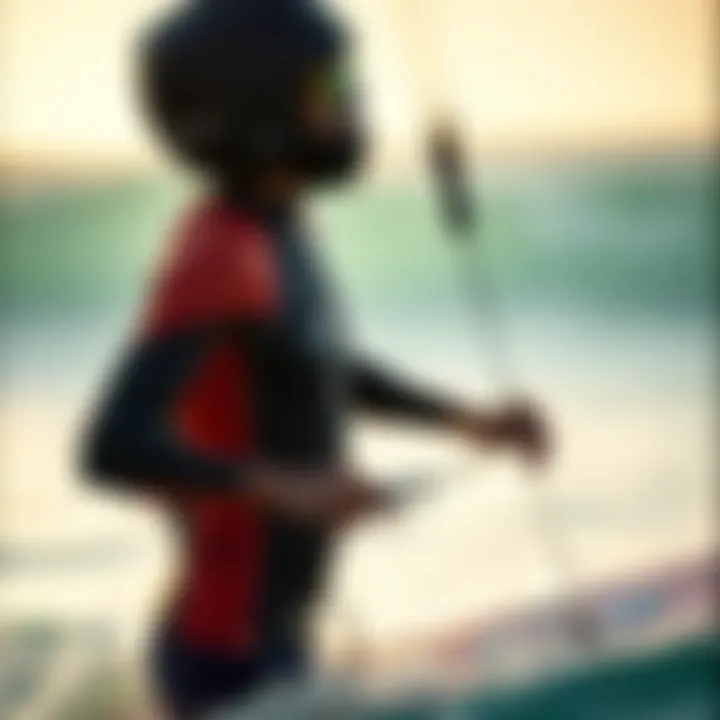
Ankle and Wrist Seals
The seals at the ankles and wrists are another critical consideration that can significantly affect your overall kiteboarding experience. These features are designed to keep water from flushing into the wetsuit.
- Importance: Well-designed seals can help maintain warmth by preventing cold water from trickling in, essential when you're getting tossed about in a gusty wind.
- Types: Options vary from traditional rubberized seals to more modern techniques like smooth skin or neoprene seals. The smoother the surface, the less water flows in.
- Considerations: Choosing a suit with comfortable and effective seals can make your rides significantly more enjoyable; ensuring they fit snug without being uncomfortably constricting;
Choosing a wetsuit is like picking a partner for your kiteboarding adventures; it's all about that right fit and connection.
Common Misconceptions About Wetsuits
Wetsuits are often surrounded by myths and misunderstandings, which can lead kiteboarders to make suboptimal choices. This section aims to shed light on common misconceptions, helping enthusiasts navigate the dos and don'ts of wetsuit selection. Knowing the truth about these myths can ultimately enhance performance and comfort on the water, which every kiteboarder should strive for.
Thicker is Always Better
One widely held belief among many is that a thicker wetsuit guarantees greater warmth and protection. While thickness does play a role in insulation, it's not as straightforward as it seems. For instance, if you opt for a suit that's too thick for 30-degree water, you might find yourself overheating, which can quickly put a damper on your kiteboarding experience.
A wetsuit that's snug yet adequately thick could provide the right balance. Here are a few points to consider:
- Thickness vs. Water Temperature: In warmer waters such as 30 degrees Celsius, a suit with a thickness of 2mm to 3mm is often sufficient. On the other hand, thicker suits are suited for much colder water conditions.
- Neoprene Quality: The type of neoprene material can impact warmth without necessarily increasing thickness. Higher-quality neoprene provides better insulation without bulkiness.
- Flexibility: A suit that is too thick may restrict movement. Kiteboarding requires agility and flexibility, so a proper fit is essential for performance.
"Choosing the right thickness is about personal preference and how long you'll spend in the water. Too thick, and you'll cook. Too thin, and you'll shiver."
Wetsuits Are Only for Cold Water
Another misunderstanding revolves around the belief that wetsuits are purely for cold water environments. While it's true that wetsuits are commonly associated with colder climes, their utility extends beyond frigid temperatures. In fact, many kiteboarders enjoy the benefits of a wetsuit in warmer waters, such as 30 degrees Celsius.
Here are some reasons to reconsider this notion:
- UV Protection: In warmer waters, a wetsuit can shield the skin from harmful UV rays. Kiteboarding often involves prolonged exposure to the sun, and some protection is paramount.
- Abrasion Resistance: Wetsuits can provide a layer of protection against scrapes and stings from marine life, coral, or even the board itself. This is particularly beneficial during energetic sessions.
- Comfort and Warmth: While the water may feel warm, sometimes a chill can set in, especially after a prolonged time on the water or when the wind picks up. A suit can help maintain a comfortable body temperature even if the water is generally warm.
No need to disregard a wetsuit just because the temperature feels inviting. Letting go of these misconceptions helps kiteboarders make informed choices, ensuring not just enjoyment on the water but also safety and wellness.
Maintaining Your Wetsuit
Keeping your wetsuit in prime condition is as crucial as picking the right one to begin with. Just like a kiteboarder wouldn’t ignore their gear maintenance, a wetsuit deserves its due attention. The longevity and performance of your wetsuit hinge on regular upkeep, which can make the difference between a comfortable ride or an unpleasant experience.
A well-maintained wetsuit not only lasts longer but also performs better. Neglecting to care for it properly can lead to damage like tears, a compromised seal, and even degradation of materials over time. Considering the investment you’ve made, taking care of your wetsuit is a no-brainer. Here are the fundamental aspects of wetsuit maintenance you should consider:
- Increased durability: Regular care extends the life of the wetsuit, allowing you to get more miles out of your investment.
- Enhanced performance: A clean and well-kept wetsuit fits better and keeps the water out, which is vital when kiteboarding in any condition.
- Odor control: Proper washing and drying techniques help in combating unpleasant smells that can accumulate after prolonged use.
Proper Cleaning Techniques
Cleaning your wetsuit isn’t as simple as tossing it into the washing machine. Here’s a step-by-step approach to ensuring it is cleaned thoroughly without causing any damage:
- Rinse Immediately: Right after you finish your session, rinse your wetsuit in fresh water. This removes salt, sand, and other debris that may harm the neoprene.
- Use Gentle Soaps: Employ a mild wetsuit cleaner. Avoid bleach or standard detergents since they can break down the material.
- Cold Water Wash: Clean it with cold water. Hot water can damage the glue and seams, compromising the suit’s integrity.
- Inside Out: Turn the wetsuit inside out while rinsing to clean the inside as well, which often gets overlooked.
- Hang Dry: Lay the wetsuit on a flat surface or hang it on a wide hanger to dry. Avoid direct sunlight, which can degrade the fabric.
While it may take a bit more time than simply tossing it in a machine, treating your wetsuit with care pays off down the line.
Storage Guidelines
When it comes to storing your wetsuit, a little care goes a long way in ensuring it’s ready for action when you are. Proper storage techniques protect it from the common culprits of damage: UV light, compression, and moisture.
Here are some best practices for storing your wetsuit:
- Avoid Folding: Store your wetsuit hanging rather than folded. Folding can create creases in the neoprene that lead to cracks over time.
- Cool, Dark Place: Keep it in a cool, dark area. Avoid garages or basements where humidity can accumulate, which may lead to mold or mildew.
- Use a Suit Bag: If available, use a specialized wetsuit bag. This keeps it protected and makes it easier to carry if you move it around.
- Regular Checks: Every couple of months, pull out your wetsuit for a quick inspection. Look for any signs of wear or damage that could worsen if left unchecked.
Proper maintenance ensures your wetsuit remains an invaluable ally in your kiteboarding ventures. Remember, it's not just gear; it's a necessity for enjoying your time on the water.
Choosing the Right Wetsuit for Specific Conditions
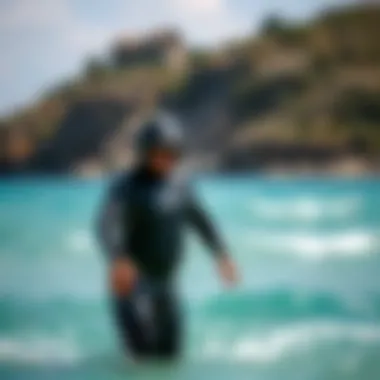
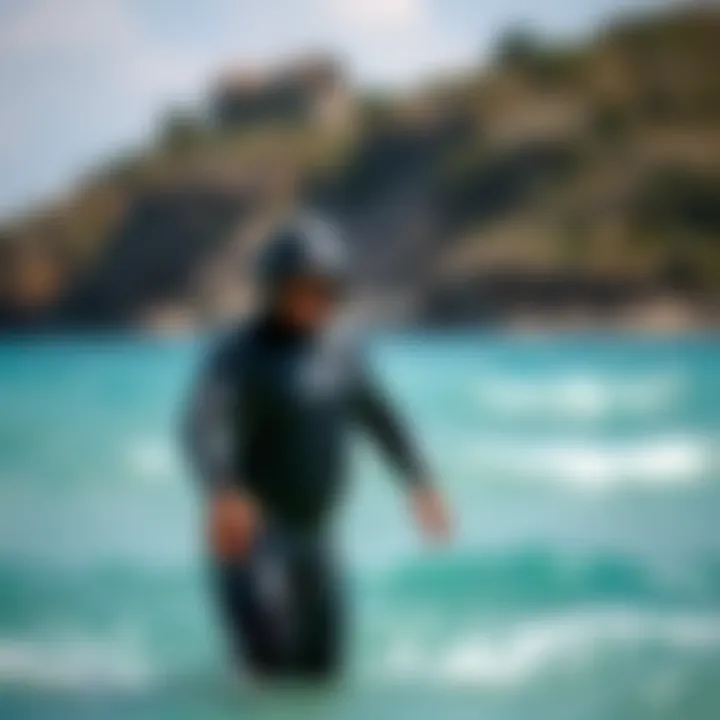
When it comes to kiteboarding, selecting the right wetsuit is crucial, particularly since conditions can vary so widely across different outings. Understanding the specific requirements based on the wind and water state not only enhances comfort but also impacts performance and safety. A thoughtfully chosen wetsuit can make the difference between a pleasant ride and an uncomfortable experience, or worse, increased risk if the conditions aren't well managed. Whether you are skimming over flat water in a gentle breeze or battling through choppy waves in gusty winds, knowing what to look for in a wetsuit tailored to these conditions is vital for maximizing your enjoyment.
For Light Winds and Flat Water
In scenarios where winds are light and the water is calm, the focus should be on flexibility and comfort rather than outright thermal protection. A thinner wetsuit, such as a shorty or a 2mm full suit, is often sufficient because the risk of hypothermia is lower due to the warmer water temperature.
- Material: Opt for a suit made from high-quality neoprene that offers stretchability, allowing for easy movement. Less insulation can mean better maneuverability, letting you perform tricks or turns without feeling restricted.
- Fit: A snug fit is important, but you don’t want it so tight that it restricts your movements. Look for a suit with flatlock seams, which are not only comfortable but also allow for a broader range of motion.
- Features: Some wetsuits intended for light wind conditions come with short sleeves or legs, which can be more comfortable for warmer weather, yet still provide necessary coverage from sun exposure or minor spills.
This combination of characteristics not only keeps you comfortable but also allows you to focus more on your skills rather than on battling discomfort from your gear.
For Strong Winds and Choppy Conditions
Navigating through strong winds and dealing with choppy water demands a wetsuit designed to handle the added stress on your body and gear. In these situations, warmth and protection become paramount, so a thicker suit that maintains flexibility is key.
- Thickness: A wetsuit between 3mm to 4mm thickness is generally favorable for these conditions. The additional thickness would help you retain core body heat, especially when water conditions are rough.
- Reinforced Areas: Look for suits with reinforced knees and seams to withstand the wear and tear from choppy conditions. Having these reinforcements adds durability, which is essential when you're often in and out of the water.
- Closure Style: A chest zip can provide better insulation than a back zip, as it prevents water from seeping in during crashes or high-impact moments. Additionally, effective seals around the ankles and wrists help keep water from flooding your suit, further maintaining body heat.
In challenging conditions, the right wetsuit acts like a second skin, enabling you to perform at your best while still prioritizing safety and comfort. More than just a piece of clothing, it's an essential investment ensuring you get the most out of your kiteboarding experience.
"Choosing the right wetsuit for the conditions isn’t merely a matter of comfort; it can significantly affect your ability to perform out there. A well-suited kiteboarder often rides with more confidence and ease."
By recognizing the distinct needs posed by different wind and water conditions, you gain insight into making informed decisions that enhance your kiteboarding sessions.
Environmental Considerations
As kiteboarding continues to gain popularity around the globe, it’s crucial for enthusiasts to be aware of the environmental impact connected to sports gear, including wetsuits. Selecting the right wetsuit not only influences your comfort and performance on the water but also contributes to the health of marine ecosystems. In this section, we will delve into two critical aspects of environmental considerations: ethical material choices and sustainable practices in kiteboarding.
Ethical Material Choices
When choosing a wetsuit, the material is among the most significant factors to consider. Traditional wetsuits are usually made from neoprene, a synthetic rubber derived from petroleum. While effective for insulation, the production of neoprene has detrimental effects on the environment. The extraction and refinement processes contribute to carbon emissions and pollution.
However, many brands have begun offering alternatives that use more eco-friendly materials. For instance, limestone-based neoprene is one such option; it significantly reduces the carbon footprint compared to its petroleum-based counterpart. Some manufacturers also utilize recycled materials, which not only helps in minimizing waste but also supports the circular economy.
Using wetsuits made from natural rubber sourced from rubber trees is another ethically responsible option. This material is biodegradable and offers similar thermal properties as traditional wetsuits. More brands are recognizing the need for sustainable production methods, embracing innovation, and creating gear that not only supports athletes but also protects the environment.
“Making thoughtful choices in gear can create ripples of change in the industry, encouraging more eco-friendly innovations.”
Sustainable Practices in Kiteboarding
Sustainability in kiteboarding goes beyond just the gear you wear; it encompasses how you interact with the aquatic environments. Understanding and implementing sustainable practices can greatly reduce your impact on marine life and their habitats. Here are some techniques enthusiasts can adopt:
- Respecting Local Regulations: Each location may have specific guidelines that protect local ecosystems, and adhering to these is paramount.
- Choosing Launch Points Wisely: Be mindful of delicate marine areas. Launching from designated spots can prevent damage to underwater habitats.
- Responsible Waste Disposal: Always carryout trash, including broken gear, to minimize littering.
- Supporting Eco-Conscious Brands: Shop from companies committed to sustainability, as this can drive demand for environmentally friendly practices in the industry.
By intertwining ethical material choices with sustainable practices, kiteboarders can enjoy the thrill of their sport while participating in the safeguarding of precious marine ecology. Every small step can lead to a larger impact, ensuring that future generations can experience the waters we so cherish.
Epilogue: Making an Informed Decision
Choosing the right wetsuit for kiteboarding in 30-degree water is not just about grabbing any suit off the rack and hitting the waves. This decision can have a direct impact on your comfort, performance, and even safety while you're out riding. Understanding the nuances involved in selecting the right wetsuit is crucial, as it allows kiteboarders to navigate varying conditions effectively.
When we dig deeper into wetsuit characteristics, it’s clear that factors such as material, thickness, and fit are paramount. A suit that hugs your body correctly will ensure that you maintain your core temperature, preventing you from feeling cold even when the water feels warm. Materials matter, too. Selecting the right kind of neoprene can make all the difference in flexibility and warmth. Not to mention, certain eco-friendly options can make you feel good about your purchase while giving back to the planet.
"An informed choice reflects not only your understanding of your personal needs but also your respect for the environment in which you thrive."
Additionally, familiarizing yourself with the maintenance aspects of a wetsuit ensures its longevity; a well-cared-for wetsuit can offer you seasons of great experiences. Regular cleaning and proper storage might seem like small tasks, but they play a significant role in extending the life of your gear.
Ultimately, making an informed decision surrounding your wetsuit will not only enrich your kiteboarding experience but also underscore the importance of being prepared and comfortable in your conditions. A thoughtful approach to your gear can elevate your skills and enjoyment on the water dramatically.
Summarizing Key Points
To wrap it all up, here are the key takeaways from this guide:
- Understanding Water Temperature: Recognizing how 30-degree water affects your body is vital for optimal comfort.
- Key Characteristics: Material types and thicknesses should align with the conditions you'll face while riding.
- Fit and Comfort: Selecting the right size and seam type ensures your suit fits like a glove.
- Additional Features: Zipper styles and seals can enhance usability and comfort.
- Misconceptions: Not all wetsuits need to be thick, and they're not only for cold water.
- Maintenance Tips: Simple care techniques will keep your wetsuit in top shape for multiple seasons.
- Environment Considerations: Choosing sustainable options not only benefits you but also the environment.
Final Thoughts on Wetsuit Selection
Selecting the right wetsuit for kiteboarding in 30-degree water transcends mere preference or aesthetics; it's about ensuring your performance is as sharp as your gear. The right wetsuit can transform your sessions, making each ride enjoyable rather than a struggle against the elements. As you explore the vastness of the water, the comfort and fit of your wetsuit will allow you to focus on what truly matters: the ride itself.
In sum, these considerations—temperature, material, fit, maintenance, and environmental impact—coalesce to guide you toward a wetsuit that fits your unique needs as a kiteboarder. A well-informed choice leads to a more gratifying experience out on the waves, and that’s what it’s all about.















